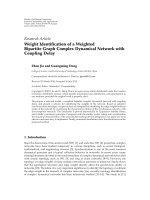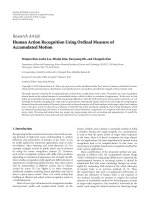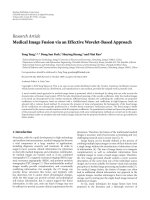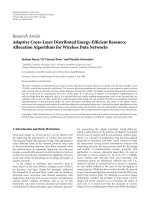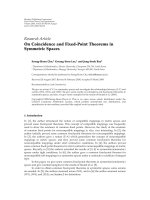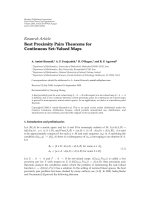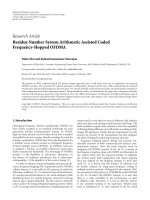Báo cáo hóa học: " Research Article Digital-Signal-Type Identification Using an Efficient Identifier" ppt
Bạn đang xem bản rút gọn của tài liệu. Xem và tải ngay bản đầy đủ của tài liệu tại đây (1.08 MB, 9 trang )
Hindawi Publishing Corporation
EURASIP Journal on Advances in Signal Processing
Volume 2007, Article ID 37690, 9 pages
doi:10.1155/2007/37690
Research Article
Digital-Signal-Type Identification Using an Efficient Identifier
Ataollah Abrahamzadeh,
1
Seyed Alireza Seyedin,
2
and Mehdi Dehghan
3
1
Faculty of Electrical and Computer Engineering, Noshirvani Institute of Technology, Mazandauan University,
P.O. Box 47148-71167, Babol, Iran
2
Faculty of Electrical Engineering, Department of Electrical Engineering, Ferdowsi University of Mashad,
P.O. Box 91779-48974, Mashad, Iran
3
Faculty of Computer Engineering and Information Technology, Amirkabir University of Technology, P.O. Box 15914,
Tehran, Iran
Received 14 September 2006; Revised 10 February 2007; Accepted 4 April 2007
Recommended by Enis Ahmet Cetin
Automatic digital-signal-type identification plays an impor t ant role for various applications. This paper presents a highly efficient
identifier (technique) that identifies a variety of digital signal types. In this technique, a selected number of the higher-order mo-
ments and the higher-order cumulants up to eighth are utilized as the effective features. A hierarchical suppor t-vector-machine-
(SVMs) based structure is proposed for multiclass classification. A genetic algorithm is proposed in order to improve the perfor-
mance of the identifier. Genetic algorithm selects the suitable parameters of SVMs that are used in the structure of the classifier.
Simulation results show that the proposed identifier has hig h performance for identification of the considered digital signal types
even at very low SNRs.
Copyright © 2007 Ataollah Abrahamzadeh et al. This is an open access article distributed under the Creative Commons
Attribution License, which permits unrestricted use, distribution, and reproduction in any medium, provided the original work is
properly cited.
1. INTRODUCTION
Automaticdigital-signal-type identification is a technique
that recognizesthe type ofreceived signal and plays an im-
portant role in various applications. For example, in mili-
tary applications, it can be employed for electronic surveil-
lance and monitoring; in civil applications, it can be used for
spectrum management, network traffic administration, sig-
nal confirmation, interference identification, software radios,
multidrop networks, intelligent modems, and so forth.
In the past, signal-type identification relied mostly on
operators scanning the radio frequency spectrum with a
wide-band receiver and checking it visually on some sort of
display [1]. Clearly, these methods relied very much on the
operators’ skills and abilities. These limitations then led to
the development of more automated modulation recogniz-
ers. One semiautomatic approach was to run the received
signal through a number of demodulators and then have an
operator to determine the modulation for mat by listening to
the output of each demodulator. This approach is however
not very practical anymore due to the new digital techniques
that transfer both voice and data. Then techniques for au-
tomatic signal-type identification started to emerge. The re-
cent contributions in the subject focus more on the digital
signal types, specially the hig her-order digital signals, due to
increasing usage of such types in many novel applications.
Automatic digital-signal-type identification techniques
usually can be categorized in two main principles: the
decision-theoretic (DT) and the pattern recognition (PR).
DT techniques use probabilistic and hypothesis testing ar-
guments to formulate the recognition problem [2, 3]. The
decision-theoretic (DT ) techniques have many drawbacks.
These techniques are not robust with respect to model mis-
match [4]. Another problem is the high computational com-
plexity [4]. Other problems are difficulties in forming the
right hypothesis testing as well as careful analysis that are re-
quired to set the correct threshold values [5]. However, PR
techniques do not need such careful treatment [5]. They are
easy to implement. PR techniques can be further divided into
two main subsystems: the feature extraction and the clas-
sifier. The former extracts the features and the latter deter-
mines the membership of signal [4–17].
In [7], the authors proposed a technique for identifica-
tion of ASK2, ASK4, PSK2, PSK4, FSK2, and FSK4 signals.
The classifier is based on a decision flow. These digital signal
types have been identified with a success rate around 90% at
2 EURASIP Journal on Advances in Signal Processing
SNR = 10 dB. In [4], the authors proposed a digital-signal
type identification technique based on elementary fourth-
order cumulant. When it was used for identification of the
BPSK, PAM4, QAM16, and PSK8, the success rate was about
96% at SNR
= 10 dB. In [8], the authors proposed a tech-
nique to discriminate among ASK, 4DPSK, 16QAM, and FSK
digital signals. The chosen features are the kurtosis of the sig-
nal, the number of peaks in the phase probability density
function (PDF), and the mean of the absolute value signal
frequency. A fuzzy classifier was used in this technique. For
SNR > 5 dB, the identifier worked properly. When SNR was
less than 5 dB, the performance was worse. In [9], for the
first time, Ghani and Lamontagne proposed using the mul-
tilayer perceptron (MLP) neural network with backpropaga-
tion (BP) learning algorithm for automatic signal-type iden-
tification. They showed that neural network classifier outper-
forms other classifiers such as K-nearest neighbor (KNN).
In [10], the authors showed that the neural network classi-
fier has a higher performance than the threshold classifier.
In [11], the authors proposed an identifier for the identifica-
tion of PSK2, PSK4, PSK8, OQPSK, MSK, QAM16, QAM64,
FSK2, and FSK4 signal types. The features chosen to charac-
terize the signal types are the mean and the next three mo-
ments of the instantaneous charac teristics. They used differ-
ent classifiers and showed that the artificial neural network
has better performance than K-nearest neighbor (KNN) clas-
sifier a nd the well known binary decision trees. They re-
porteda success rate of 93% w ith SNR range 15–25 dB. How-
ever, the performance for lower SNRs is reported to be less
than 80%. In [12], the authors proposed an identifier based
on cyclic spectral features for identification of AM, USB, LSB,
FM, ASK, FSK, BPSK, QPSK, and SQPSK. It was claimed
that cyclic spectrum posses more advantage than power spec-
trum in signal-type recognition. A full-connected backprop-
agation neural network is used for classification in that re-
search. The success rate of this identifier is reported around
90% with SNR range 5–25 dB. In [5], the authors have used a
combination of spectral features and statistical features (sec-
ond, third, and fourth orders of cumulants) for identifica-
tion of ASK2, ASK4, PSK2, PSK4, FSK2, FSK4, V29, V32,
QAM16, and QAM64. The classifier was an MLP neural net-
work. T hey reported a high success r ate at most of SNRs.
The authors did not clarify the correction percentage of each
of the modulations individually. Also they have used a fully
connected neur al network. This causes a long training time
as well as the high complexity of the classifier. If the number
of samples reduces, the performance will drop. In [13], the
authors have done a comparative study of implementation
of feature extraction and classification algorithms based on
discrete wavelet decompositions and adaptive-network based
fuzzy interference System (ANFIS) for recognition of ASK8,
FSK8, PSK8, and QASK8.
It can be found that the techniques that use MLP neural
networks as the classifier have high performances. However,
with regard to effectiveness of MLP neural networks, there
are some problems. For example, MLP neural networks have
limitations on generalization ability in low SNRs. Another
main drawback of the MLP models is that the training proce-
dure often gets stuck at a local optimum of the cost function
[15].
In recent years, support vector machines (SVMs), based
on statistical learning theory, are gaining applications in area
of pattern recognition and detection of microcalcifications
in digital mammograms, because of excellent generalization
capability [18]. In [14], the authors proposed an identifier
for signal-type identification that uses a binary SVM as the
classifier. The features were extracted using wavelet packet
analysis and biorthogonal wavelet. The accuracy of the pro-
posed identifier exceeds 98% for SNR > 4dB. In [15], Wu
et al. introduced an identifier for automatic digital modu-
lation recognition method based on SVMs. They have used
the five key features that are introduced in [7]. It is shown
that this method can achieve a satisfying performance at
an SNR as low as 5 dB. This algorithm can recognize the
modulation types of ASK2, ASK4, FSK2, FSK4, PSK2, and
PSK2. As mentioned in [5], these features are only suitable
for these low orders of s ignals that contain hidden infor-
mation only in instantaneous amplitude, the instantaneous
phase, and/or the instantaneous frequency. Using the higher-
order statistics makes higher performances for fault detec-
tion systems [18, 19]. In [16], the authors proposed four fea-
tures to classify ASK2, ASK4, PSK2, PSK4, FSK2, and FSK4.
The features were extracted based on two main processing
steps. The first step is the multiplication of two consecu-
tive signal values. In the second step, the mean, the kurto-
sis of real and imaginary parts of the quantity obtained in
the first step were used as the input features of the SVMs.
In [17], Gang et al. proposed an identifier for recognition
of ASK4, PSK2, PSK4, PSK8, and QAM16. The probabil-
ity of correct classification was about 98% at an SNR of
4dB.
From the published works, it can be found that the iden-
tifiers, which use the statistical features, are able to include
the digital signal types such as QAM and higher orders of dig-
ital signals. Also, the techniques that use SVMs as the classi-
fier have high performances at low-level SNRs. In this paper,
we propose a highly efficient identifier which contains the
mentioned specifications. It uses a selected combination of
the higher-order moments and the higher-order cumulants
(up to eighth) as the effective features for representation of
digital signals. We have proposed a new and simple multi-
class SVM-based classifier that has a hierarchical structure.
Suitable parameters of SVMs can improve the performance
of the identifier. We have proposed a genetic algorithm (GA)
for tuning the parameters of SVMs that are used in the pro-
posed classifier.
Figure 1 shows the general scheme of the proposed iden-
tifier. The preprocessing module performs actions such as
rejection of noise outside of the signal bandwidth, carrier
frequency estimation (or to be known), recovery of com-
plex envelope. This stage is similar in most of the techniques,
and hence we will not explain it more. The feature extrac-
tion module is presented in Section 2. Also the digital signal-
types set (DSTS) that is considered in this paper is introduced
in Section 2. The classifier module is descr ibed in Section 3.
Optimization problem using GA is presented in Section 4.
Ataollah Abrahamzadeh et al. 3
Feature extraction
Classifier
Optimization
Preprocessing
Received signal
Digital signal type
Figure 1: General scheme of the proposed identifier.
Section 5 shows some simulation results. Finally, Section 6
concludes the paper.
2. DSTS AND FEATURE EXTRACTION
Different types of digital signal have different characteris-
tics. Therefore finding the proper features for the recognition
of digital signals, particularly in case of higher-order and/or
nonsquare kinds of digital signal, is a serious problem. In this
paper, DSTS is ASK4, ASK8, PSK2, PSK4, PSK8, Star-QAM8,
V29, QAM32, and QAM64. Because of simplifying the indi-
cation, the digital signal types of ASK4, ASK8, PSK2, PSK4,
PSK8, Star-QAM8, V29, QAM32, and QAM64 are substi-
tuted with P
1
,P
2
,P
3
,P
4
,P
5
,P
6
,P
7
,P
8
,andP
9
,respectively.
Among the different features that we have computed and ex-
perimented, the higher-order moments and higher-order cu-
mulants (up to eighth) make the highest performances for
identification of DSTS. These features can provide a fine way
to describe the shape of the probability density function. The
following subsections briefly describe these features.
2.1. Moments
Probability distribution moments are a generalization of the
concept of the expected value. Recall that the genera l expres-
sion for the ith moment of a random variable is given by [20]
μ
i
=
∞
−∞
(s − m)
i
f (s)ds,(1)
where m is the mean of the random variable. The definition
for the ith moment for a finite length discrete signal is given
by
μ
i
=
N
k=1
s
k
− μ
i
f
s
k
,(2)
where N is the data length. In this study, signals are assumed
to be zero mean. Thus,
μ
i
=
N
k=1
s
i
k
f
s
k
. (3)
Next, the automoment of the random variable may be de-
fined as follows:
M
pq
= E
s
p−q
s
∗
q
,(4)
Table 1: Some of the features for a number of digital signal types.
P
1
P
3
P
4
P
6
P
9
M
41
1.64 1 0 0 0
M
61
2.92 1 −12.92−1.3
C
63
8.32 16 4 .160 1.79
M
84
5.24 1 1 5.25 3.96
C
80
−30.1 −244 34 −88.9 −11.5
C
82
−30.1 −244 −46 63.31 −27.1
where p is called the moment order and s
∗
stands for com-
plex conjugation of s.
Assume a zero-mean discrete basedband signal sequence
of the form s
k
= a
k
+ jb
k
. Using the definition of the auto-
moments, the expressions for different orders may be easily
derived. For example,
M
41
= E
(a + jb)
3
(a − jb)
=
E
a
4
− b
4
. (5)
2.2. Cumulants
Consider a scalar zero-mean random variable s with charac-
teristic function:
f (t) = E
e
jts
. (6)
Expanding the logarithm of the characteristic function as a
Taylor series, one obtains
log
f (t) = k
1
( jt)+···+
k
r
( jt)
r
r!
+
···. (7)
The constants k
r
in (7) are called the cumulants (of the dis-
tribution) of s. The symbolism for pth order of cumulant is
similar to that of the pth-order moment. More specially,
C
pq
= Cum
s, , s
(p−q)terms
, s
∗
, , s
∗
(q)terms
. (8)
For example:
C
81
= Cum
s, s, s, s, s, s, s, s
∗
. (9)
We have computed all of the features for DSTS. Tabl e 1
shows some of these features for a number of the consid-
ered digital signal types. These values are computed under
the constraints of unit variance and noise free.
3. CLASSIFIER
We have proposed a multiclass SVM-based classifier that has
a hierarchical structure. SVMs were introduced on the foun-
dation of statistical learning theory. The basic SVM deals
with two-class problems; however, it can be developed by
some special methods for multiclass classification [21]. Bi-
nary SVM performs classification tasks by constructing the
optimal separating hyperplane (OSH). OSH maximizes the
margin between the two nearest data points belonging to the
two separate classes.
4 EURASIP Journal on Advances in Signal Processing
Suppose that thetraining set (x
i
, y
i
), i = 1, 2, , l, x ∈
R
d
, y ∈{−1, +1}, can be separated by the hyperplane
w
T
x + b = 0, where w is the weight vector and b is the bias.
If this hyperplane maximizes the margin, then the following
inequality is valid for all input data:
y
i
w
T
x
i
+ b
≥ 1, ∀x
i
, i = 1, 2, , l. (10)
Those training points, for which the equality in (10)holds,
are called support vectors (SVs). The margin of the hyper-
planeisequalto2/
w. Thus, the problem is the maximizing
of the margin by minimizing of
w
2
subject to (10). This is
a convex quadratic programming (QP) problem. Lagrange
multipliers (α
i
, i = 1, , l; α
i
≥ 0) are used to solve it. Hav-
ing done some computations, the optimal values w and b are
achieved. Then the optimal decision function (ODF) is then
given [21]:
f (x)
= sgn
l
i=1
y
i
α
∗
i
x
T
x
i
+ b
∗
, (11)
where α
∗
i
’s are optimal Lagrange multipliers.
For inputs data with a high noise level, SVM uses soft
margins that can be expressed as follows with the introduc-
tion of the nonnegative slack variables ξ
i
, i = 1, , l:
y
i
w
T
x
i
+ b
≥
1 − ξ
i
for i = 1, 2, , l. (12)
To obtain the OSH, the Φ
= (1/2)w
2
+ C
l
i
=1
ξ
k
i
should
be minimized subject to (12), where C is the penalty param-
eter, which controls the tradeoff between the complexity of
the decision function and the number of training examples,
misclassified.
In the nonlinearly separable cases, the SVM map the
training points, nonlinearly, to a high-dimensional feature
space using kernel function K(
x
i
,
x
j
), where linear separa -
tion may be possible. Gaussian radial basis function (GRBF)
is one of the kernelfunctions. It is given by
K(x, y)
= exp
−
x − y
2
2σ
2
, (13)
where σ is the width of the RBF kernel. After a kernel func-
tion is selected, the decision function will become
f (x)
= sgn
l
i=1
y
i
α
∗
i
K
x, x
i
+ b
∗
. (14)
The performance of an SVM depends on penalty param-
eter (C) and the kernel parameter, which are called hyperpa-
rameters. In this paper, we have used the GRBF, because our
extensive simulation shows that it has better performance
than other kernels. Thus hyperparameters are C and σ.
There are two widely used methods to extend binary
SVMs to multiclass problems: one-against-all (OAA) method
and one-against-one (OAO) method [22]. In this paper, we
have proposed a hierarchical SVM-based classifier. Figure 2
shows the scheme of this classifier. One of the advantages of
this structure is that the number of SVMs is less than in cases
of OAO and OAA.
SVM1
SVM3
SVM2
SVM4
SVM5
SVM6
SVM7SVM8 V29
PSK2
ASK4
ASK8
PSK4
PSK8
QAM32
QAM64
Star-QAM8
Figure 2: Hierarchical SVM-based classifier.
4. GA FOR SELECTION OF THE PARAMETERS OF SVMS
Finding the optimum values of the hyperparameters im-
proves the performance of SVMs; however, it is a difficult
problem [23]. GAs w ith their characteristics of high effi-
ciency and global optimization are widely applied in many
areas. In this paper, we have used GA for finding the opti-
mumvaluesofhyperparametersofSVMs.GAisastochas-
tic optimization algorithm, which adopts Dar win’s theory of
survival of the fittest. To apply a genetic algorithm, one has
to define its basic issues.
Selection of the parameters of SVM is an optimization
problem with constraints. Here, real-encoded scheme is se-
lected as the representation of the parameters. The research
space of these par ameters is C∈[2 : 4 : 50], σ ∈ [0.1:0.1:2].
The size of the population (pop
size) is chosen to be 16 in
ordertoavoiddifficulties in the convergence of the popula-
tion. For producing the initial population, the initial values
of the designed parameters are distributed in the solution
space as even as possible. According to the aforementioned
analysis, the average performance of the SVM classifier is de-
pendent on E
{R
2
/γ
2
) and not simply on the large margin γ.
The radius-margin bound is proposed as the fitness function
[23]:
T
=
1
l
R
2
γ
2
, (15)
where γ denotes the margin, l is the size of the training sam-
ples, R is the radius of the smallest sphere containing the
training data, R
= 0.5.
Genetic operators include selection operator, crossover
operator, and mutation operator. Here the method of sur-
vival of the fittest was used to select the next-generation in-
dividual. Given the fitness function fit(a
i
) of the individual
a
i
, the probability of a
i
selected as the next generation one is
as follows:
P
a
i
=
fit
a
i
pop size
j=1
fit
a
j
×
pop size. (16)
Ataollah Abrahamzadeh et al. 5
Table 2: Chosen features for each SVM.
Number of SVMs Chosen features
SVM1 C
81
SVM2 M
41
SVM3 M
41
, C
81
SVM4 M
63
SVM5 C
61
SVM6 C
63
SVM7 M
82
, C
80
SVM8 M
61
, C
80
Thecrossoveroperatorisdefinedas[24]
X
= aX
1
+(1− a)X
2
, (17)
where X
is the offspring aftercrossover operation, X
1
and X
2
are two parents to be implemented in the crossover opera-
tion, and a is a constant which belongs to (0, 1). Here a
= 0.5.
How the bigger value of the mutation operator is chosen to
maintain the diversity of the population in the early GA oper-
ation and avoid the precocity? The adaptive mutation proba-
bility is adopted in this paper to solve the above two problems
as follows:
P
m
=
exp(−b × t/2)
pop size ×
√
L
, (18)
where t is the generation of the genetic iteration, pop
size is
the size of the population, L is the length of the individual,
b
= 1.5isapresetparameter.Inthispaper,geneticalgo-
rithm terminates the program when the best fitness has not
changed more than a very small value, that is, 10
−6
over the
last generations.
5. SIMULATION RESULTS
We have used Matlab environment for simulations. The sim-
ulated signals were band-limited and Gaussian noise was
added according to SNR values
−3, 0, 3, 6, 9, and 18 dB. For
each signal type, 1260 samples are used for simulations. Six
hundred and thirty s amples are used for training phase and
630 samples are used for testing phase. Among the features
that we have mentioned in Section 2, Tab le 2 shows the cho-
sen features that achieve the best results for identification of
DSTS. These features were selected based on tr y and error.
5.1. Performance without optimization
Based on some experiments, the values σ=1andC = 10
are selected for all SVMs. Ta ble 3 shows the diagonal matrix
(DM) or accuracy matrix (ACCM) at SNR
= 3dB. Table 4
shows the identification results (performances) for DSTS in
different SNR values. These are the averages of the values that
appear in the diagonal of DM (or ACCM). It can be seen
that the performance is generally very good even at very low
SNRs. This is due to two facts: chosen features and novel clas-
sifier. The chosen features have the effective properties in sig-
nal representation. On the other hand, SVM-based classifier
has high generalization ability for classification of the con-
sidered digital signals at low SNRs.
In order to compare the performance of the proposed
hierarchical SVM-based classifier with another classifier, we
have considered a hierarchical MLP-based classifier in which
SVMs are replaced with MLP neural networks. These MLPs
use backpropagation with momentum and adaptive learning
rate algorithm. The simulation setups are the same. We name
this technique as TECH2. Figure 3 shows the per formances
of two identifiers in different SNR values. It can be seen that
the proposed technique (PROTECH) that uses SVM in the
structure of its classifier has higher accuracy than TECH2,
particularly, in low levels of SNR. When SNR is low, TECH2
shows poor performance, w hile in higher SNR the accuracy
is higher. The construction of neural network in l ow SNRs
is not proper, which results in low generalization ability. In
higher SNRs, the features are proper and closer to the noise-
less state and it is easier to constru ct the neural network and
results in high identification probability.
In order to indicate the effectiveness of the chosen fea-
tures, we have used the features that have been introduced in
[4]. The structure of the classifier and the simulation setups
are the same. We name this technique as TECH3. Figure 4
shows the performances of two identifiers. Results imply that
our chosen features have highly effective properties in signal
representation.
5.2. Performance with applying GA
In this section, we apply GA for finding the optimum pa-
rameters of SVMs that are in the structure of the proposed
classifier. Tabl e 5 shows the performances of the optimized
identifier for various SNRs. Figure 5 shows a comparison
between the performances of the nonoptimized technique
(PROTECH) and optimized technique (OPROTECH). It can
be seen that the optimization improves the performances
of identifier for all SNRs, especially in lower SNRs. Tab le 6
shows the optimum parameters of SVMs that are used in the
hierarchical structure. Table 7 indicates the diagonal matrix
of identifier at SNR
= 3 dB. Also, we have computed the per-
formances of the optimized identifier at a high SNR value.
Tab le 8 indicates the training performance of the identifier at
SNR
= 40 dB. It can be seen that the proposed identifier can
show up to 100% accuracy.
5.3. Performance comparison
As mentioned in [5], direct comparison with other works is
too difficult in signal-type identification. This is mainly be-
cause of the fact that there is no available single unified data
set. Different setups of digital signal types will lead to dif-
ferent performances. Compared with other identifiers men-
tioned in Section 1, the proposed identifier in this paper has
many advantages. This identifier has a simple st ructure and
includes a variety of digital signal types. Each SVM in the
identifier uses the features vector in order to map the input
vectors’ nonlinearity into high-dimensional feature space in
a nonlinear manner and constructs the optimum separating
6 EURASIP Journal on Advances in Signal Processing
Table 3: Testing performance of the proposed identifier at SNR = 3dB.
P
1
P
2
P
3
P
4
P
5
P
6
P
7
P
8
P
9
P
1
97
P
2
92
P
3
99
P
4
95
P
5
93
P
6
91
P
7
92
P
8
91
P
9
92
Table 4: Performances of the proposed identifier in different SNRs
without optimization (%).
SNR Training Testing
−3 86.14 85.52
0 93.26 91.45
3 94.42 93.56
6 96.75 96.54
9 97.85 97.56
18 98.74 98.50
Table 5: Performances of the identifier with applying of GA.
SNR (dB) Training Testing
−3 92.74 92.26
0 94.92 93.64
3 96.84 96.78
6 98.95 98.75
9 99.14 99.12
18 99.58 99.36
Table 6: Optimum parameters of SVMs.
SVM’s number Cσ
SVM1 2 1.2
SVM2 10 1.4
SVM3 14 0.9
SVM4 18 1
SVM5 42 0.9
SVM6 26 1.1
SVM7 16 0.9
SVM8 22 0.7
hyperplane in the space to realize signal recognition. This
classifier avoids the overfitting and local minimum. It shows
great generalization ability for identifying the considered dig-
ital signal types. The proposed identifier has a success rate of
around 92% at SNR
=−3 dB. The performance of the iden-
tifier is higher than 98% for SNR > 6 dB. These performances
are achieved with few samples.
50
80
100
Pc
−3 6 12 18
SNR
PROTECH
TECH2
Figure 3: Comparison between the performances of PROTECH
and TECH2.
6. CONCLUSIONS
Automatic digital-signal-type identification has seen increas-
ing demand in different applications. Most of the proposed
techniques can only identify low orders of digital signals.
They usually require high levels of SNR for identification of
the considered digital signals. These problems are mainly due
to two facts: the features and the classifier. In this paper, we
have used a selected combination of the higher-order mo-
ments and the higher-order cumulants u p to eighth as the
effective features for representation of the digital signal types.
These features are selected based on try and error. As the
classifier, we have proposed a hierarchical multiclass classi-
fier based on SVMs. This classifier has a simple st ructure and
high generalization ability. By using the mentioned features
and the classifier, we have presented a highly efficient iden-
tifier. This identifier is able to recognize different types of a
digital signal and has a high performance at very low levels
of SNR. Optimization of the structure of the classifier im-
proves success rate of the identifier. Therefore, we have used
Ataollah Abrahamzadeh et al. 7
Table 7: Testing performance of the optimized identifier at SNR = 3dB.
P
1
P
2
P
3
P
4
P
5
P
6
P
7
P
8
P
9
P
1
98
P
2
98
P
3
100
P
4
100
P
5
97
P
6
96
P
7
96
P
8
94
P
9
92
Table 8: Training performance of the optimized identifier at SNR = 40 dB.
P
1
P
2
P
3
P
4
P
5
P
6
P
7
P
8
P
9
P
1
100
P
2
100
P
3
100
P
4
99.8
P
5
100
P
6
100
P
7
99.6
P
8
100
P
9
99.6
40
50
80
100
Pc
−3 6 12 18
SNR
PROTECH
TECH3
Figure 4: Comparison between the performances of PROTECH
and TECH3.
a genetic algorithm as an optimizer in order to achieve the
optimum structure of the classifier. This work improves ef-
ficiently the performance of the identifier, especially at very
low SNRs. For future works, we can use a nother genetic al-
gorithm and compare the respective results with the results
84
88
92
96
100
Pc
−3 6 12 18
SNR
OPROTECH
PROTECH
Figure 5: Comparison between the performances of the nonopti-
mized technique (PROTECH) and optimized technique (OPRO-
TECH).
presented in this paper. We can select the proper features in-
troduced by others and use them together with the features
that are proposed in this paper in order to have suitable fea-
tures set for identification of the different types of a digi-
tal signal. In this paper, we have used the genetic algorithm
8 EURASIP Journal on Advances in Signal Processing
for optimization of the structure of the classifier. For future
works, we can apply the genetic algorithm both for the fea-
tures subset selection and the optimization of the structure
of the classifier.
REFERENCES
[1] A. Iversen, “The use of artificial neural networks for auto-
matic modulation recognition,” Tech. Rep. HW-MACS-TR-
0009, Heriot-Watt University, Edinburgh, Scotland, December
2003.
[2] W. Wei and J. M. Mendel, “Maximum-likelihood classification
for digital amplitude-phase modulations,” IEEE Transactions
on Communications, vol. 48, no. 2, pp. 189–193, 2000.
[3] P. Panagiotou, A. Anastasopoulos, and A. Polydoros, “Likeli-
hood ratio tests for modulation classification,” in Proceedings
of the 21st Century Military Communications Conference (MIL-
COM ’00), vol. 2, pp. 670–674, Los Angeles, Calif, USA, Octo-
ber 2000.
[4] A. Swami and B. M. Sadler, “Hierarchical digital modulation
classification using cumulants,” IEEE Transactions on Commu-
nications, vol. 48, no. 3, pp. 416–429, 2000.
[5] M. L. D. Wong and A. K. Nandi, “Automatic digital modu-
lation recognition using artificial neural network and genetic
algorithm,” Signal Processing, vol. 84, no. 2, pp. 351–365, 2004.
[6] B. G. Mobasseri, “Digital modulation classification using con-
stellation shape,” Signal Processing, vol. 80, no. 2, pp. 251–277,
2000.
[7] E. E. Azzouz and A. K. Nandi, “Automatic identification of dig-
ital modulation types,” Signal Processing, vol. 47, no. 1, pp. 55–
69, 1995.
[8] J. Lopatka and M. Pedzisz, “Automatic modulation classifica-
tion using statistical moments and a fuzzy classifier,” in Pro -
ceedings of the 5th International Conference on Signal Processing
(ICSP ’00), vol. 3, pp. 1500–1506, Beijing, China, August 2000.
[9] N. Ghani and R. Lamontagne, “Neural networks applied to
the classification of spectral features for automatic modulation
recognition,” in Proceedings of IEEE Military Communications
Conference (MILCOM ’93), vol. 1, pp. 111–115, Boston, Mass,
USA, October 1993.
[10] A. K. Nandi and E. E. Azzouz, “Algorithms for automatic mod-
ulation recognition of communication signals,” IEEE Transac-
tions on Communications, vol. 46, no. 4, pp. 431–436, 1998.
[11] C. Louis and P. Sehier, “Automatic modulation recognition
with a hierarchical neural network,” in Proceedings of IEEE
Military Communications Conference (MILCOM ’94), vol. 3,
pp. 713–717, Fort Monmouth, NJ, USA, October 1994.
[12] L. Mingquan, X. Xianci, and L. Leming, “Cyclic spectral fea-
tures based modulation recognition,” in Proceedings of Inter-
national Conference on Communication Technology (ICCT ’96),
vol. 2, pp. 792–795, Beijing, China, May 1996.
[13] E. Avci, D. Hanbay, and A. Varol, “An exper t discrete wavelet
adaptive network based fuzzy inference system for digital
modulation recognition,” Expert Systems with Applications,
vol. 33, no. 3, pp. 582–589, 2007.
[14] A. Abrahamzadeh and S. A. Seyedin, “Automatic modulation
type identification using WPA and SVM,” International Jour-
nal of Tomography & Statistics, vol. 4, pp. 17–28, 2006.
[15] Z. Wu, X. Wang, Z. Gao, and G. Ren, “Automatic digital modu-
lation recognition based on support vector machines,” in Pro-
ceedings of International Conference on Neural Networks and
Brain (ICNNB ’05), vol. 2, pp. 1025–1028, Beijing, China, Oc-
tober 2005.
[16] H. Mustafa and M. Doroslova
ˇ
cki, “Digital modulation recog-
nition using support vector machine classifier,” in Proceed-
ings of the 38th Asilomar Conference on Signals, Systems and
Computers, vol. 2, pp. 2238–2242, Pacific Grove, Calif, USA,
November 2004.
[17] H. Gang, L. Jiandong, and L. Donghua, “Study of modulation
recognition based on HOCs and SVM,” in Proceedings of the
59th IEEE Vehicular Technology Conference (VTC ’04), vol. 2,
pp. 898–902, Milan, Italy, May 2004.
[18] I. El-Naqa, Y. Yang, M. N. Wernick, N. P. Galatsanos, and R. M.
Nishikawa, “A support vector machine approach for detection
of microcalcifications,” IEEE Transactions on Medical Imaging,
vol. 21, no. 12, pp. 1552–1563, 2002.
[19] M. N. G
¨
urcan, Y. Yardimci, A. E. C
¸ etin, and R. Ansari, “Detec-
tion of microcalcifications in mammograms using higher or-
der statistics,” IEEE Signal Processing Letters, vol. 4, no. 8, pp.
211–216, 1997.
[20] P. McCullagh, Tensor Methods in Statistics, Chapman & Hall,
London, UK, 1987.
[21] C. Cortes and V. Vapnic, “Support vector network,” Machine
Learning, vol. 20, no. 3, pp. 273–297, 1995.
[22] B. Sch
¨
olkopf, C. Burges, and V. Vapnik, “Extracting sup-
port data for a given task,” in Proceedings of the 1st Interna-
tional Conference on Knowledge Discovery and Data Mining
(KDD ’95), pp. 252–257, Montreal, Canada, August 1995.
[23] O. Chapelle, V. Vapnik, O. Bousquet, and S. Mukherjee,
“Choosing multiple parameters for support vector machines,”
Machine Learning, vol. 46, no. 1–3, pp. 131–159, 2002.
[24] Z. Michalewicz, Genetic Algorithms+Data Structures=Evolu-
tion Programs, Springer, New York, NY, USA, 3rd edition,
1999.
Ataollah Abrahamzadeh was born in
Babolsar at the north of Iran. He received
his Ph.D. degree in electrical engineering
from Ferdowsi University of Mashad,
Mashad, Iran, in 2006. Now he is an Assis-
tant Professor in the Faculty of Electrical
and Computer Engineering at Noushirvani
Institute of Technology. His current scien-
tific interests are in general area of signal
processing, biomedical engineering, and
artificial intelligence.
Seyed Alireza Seyedin wasborninIran.He
received the B.S. degree in electronics en-
gineering from Isfahan University of Tech-
nology, Isfahan, Iran, in 1986 and the M.E.
degree in control engineering from Roorkee
University, Roorkee, India, in 1992 and the
Ph.D. degree in electrical engineering from
the University of New South Wales, Sydney,
Australia, in 1996. Since 1996, he has been
with the Faculty of Engineering, Ferdowsi
University of Mashhad, Mashhad, Iran, as an Assistant Professor.
He was the Head of the Department of Electrical Engineering for
the period 1998–2000. He is a Member of Scientific Committee
of the Iranian Conference on Machine Vision and Image Process-
ing. His current research interests include image analysis, digital
signal processing, robotics, machine vision, and pattern recogni-
tion.
Ataollah Abrahamzadeh et al. 9
Mehdi Dehghan received his B.S. deg ree in
computer engineering from Iran University
of Science and Technology (IUST), Tehran,
Iran, in 1992, and his M.S. and Ph.D. de-
grees from Amirkabir University of Tech-
nology (AUT), Tehran, Iran, in 1995, and
2001, respectively. He is an Assistant Profes-
sor of Computer engineering and informa-
tion technology at Amirkabir University of
Technology (AUT). Prior to joining AUT in
2004, he was a Research Scientist at Iran Telecommunication Re-
search Center (ITRC) working in the area of quality-of-service pro-
visioning and network management. His research interests are in
wireless networks, pattern recognition, fault-tolerant computing,
and distributed systems.
